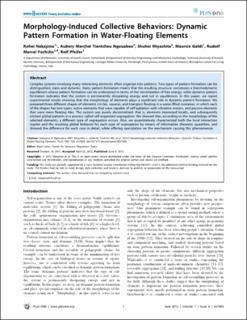Please use this identifier to cite or link to this item:
https://doi.org/10.21256/zhaw-1666| Publication type: | Article in scientific journal |
| Type of review: | Peer review (publication) |
| Title: | Morphology-induced collective behaviors : dynamic pattern formation in water-floating elements |
| Authors: | Nakajima, Kohei Tientcheu Ngouabeu, Aubery Marchel Miyashita, Shuhei Göldi, Maurice Füchslin, Rudolf Marcel Pfeifer, Rolf |
| DOI: | 10.21256/zhaw-1666 10.1371/journal.pone.0037805 |
| Published in: | PLOS ONE |
| Volume(Issue): | 7 |
| Issue: | 6/e37805 |
| Issue Date: | 2012 |
| Publisher / Ed. Institution: | Public Library of Science |
| ISSN: | 1932-6203 |
| Language: | English |
| Subject (DDC): | 530: Physics |
| Abstract: | Complex systems involving many interacting elements often organize into patterns. Two types of pattern formation can be distinguished, static and dynamic. Static pattern formation means that the resulting structure constitutes a thermodynamic equilibrium whose pattern formation can be understood in terms of the minimization of free energy, while dynamic pattern formation indicates that the system is permanently dissipating energy and not in equilibrium. In this paper, we report experimental results showing that the morphology of elements plays a significant role in dynamic pattern formation. We prepared three different shapes of elements (circles, squares, and triangles) floating in a water-filled container, in which each of the shapes has two types: active elements that were capable of self-agitation with vibration motors, and passive elements that were mere floating tiles. The system was purely decentralized: that is, elements interacted locally, and subsequently elicited global patterns in a process called self-organized segregation. We showed that, according to the morphology of the selected elements, a different type of segregation occurs. Also, we quantitatively characterized both the local interaction regime and the resulting global behavior for each type of segregation by means of information theoretic quantities, and showed the difference for each case in detail, while offering speculation on the mechanism causing this phenomenon. |
| URI: | https://digitalcollection.zhaw.ch/handle/11475/2792 |
| Fulltext version: | Published version |
| License (according to publishing contract): | CC BY 4.0: Attribution 4.0 International |
| Departement: | School of Engineering |
| Appears in collections: | Publikationen School of Engineering |
Files in This Item:
| File | Description | Size | Format | |
|---|---|---|---|---|
| 2012_Nakajima_Morphology-induced collective behaviors_PLoS ONE.pdf | 1.33 MB | Adobe PDF |  View/Open |
Show full item record
Nakajima, K., Tientcheu Ngouabeu, A. M., Miyashita, S., Göldi, M., Füchslin, R. M., & Pfeifer, R. (2012). Morphology-induced collective behaviors : dynamic pattern formation in water-floating elements. Plos One, 7(6/e37805). https://doi.org/10.21256/zhaw-1666
Nakajima, K. et al. (2012) ‘Morphology-induced collective behaviors : dynamic pattern formation in water-floating elements’, PLOS ONE, 7(6/e37805). Available at: https://doi.org/10.21256/zhaw-1666.
K. Nakajima, A. M. Tientcheu Ngouabeu, S. Miyashita, M. Göldi, R. M. Füchslin, and R. Pfeifer, “Morphology-induced collective behaviors : dynamic pattern formation in water-floating elements,” PLOS ONE, vol. 7, no. 6/e37805, 2012, doi: 10.21256/zhaw-1666.
NAKAJIMA, Kohei, Aubery Marchel TIENTCHEU NGOUABEU, Shuhei MIYASHITA, Maurice GÖLDI, Rudolf Marcel FÜCHSLIN und Rolf PFEIFER, 2012. Morphology-induced collective behaviors : dynamic pattern formation in water-floating elements. PLOS ONE. 2012. Bd. 7, Nr. 6/e37805. DOI 10.21256/zhaw-1666
Nakajima, Kohei, Aubery Marchel Tientcheu Ngouabeu, Shuhei Miyashita, Maurice Göldi, Rudolf Marcel Füchslin, and Rolf Pfeifer. 2012. “Morphology-Induced Collective Behaviors : Dynamic Pattern Formation in Water-Floating Elements.” Plos One 7 (6/e37805). https://doi.org/10.21256/zhaw-1666.
Nakajima, Kohei, et al. “Morphology-Induced Collective Behaviors : Dynamic Pattern Formation in Water-Floating Elements.” Plos One, vol. 7, no. 6/e37805, 2012, https://doi.org/10.21256/zhaw-1666.
Items in DSpace are protected by copyright, with all rights reserved, unless otherwise indicated.